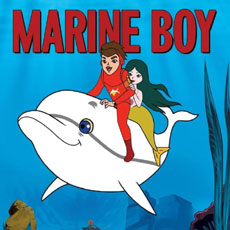Japan Tele-Cartoons/Warner Bros. – Seven Arts (1966), Warner Archive (March 12, 2013), 3 Discs, 328 mins, 4:3 ratio, Dolby Digital Mono, Not Rated, Retail: $29.95
Storyboard:
A young adventurer patrols the sea on behalf of the Ocean Patrol.
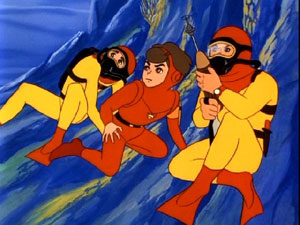
The Sweatbox Review:
I always thought that I had a pretty complete knowledge of Saturday morning cartoons, so I was quite bamboozled when Warner Home Video released their DVD set Saturday Morning Cartoons – 1960s: Volume 1 in the spring of 2009, and I saw that there was a cartoon on there that I had never heard of. (Of course, I wasn‘t alive in the 1960s, so I suppose I couldn’t expect to know everything about the era.) “What the heck is Marine Boy?” I asked. Information on the Net was scarce, too, though I did find some reference to its Japanese origins. Four years later, I was a little amazed, but pleased, when Warner Archive announced plans to release the complete first season in its own three-disc set.

The Internet continues to grow, so I was now able to find more information about the show. It actually has an interesting history, beginning as a black-and-white three-episode pilot (Dolphin Prince) in Japan, that morphed into a thirteen episode color series called Hang On! Marine Kid. That version was unsuccessful in the ratings for Japanese television network TBS, and it was cancelled; but it was still promoted by a program seller for sale abroad, and he captured the attention of Seven Arts Television. Seven Arts (which later merged with Warner Bros.) agreed to buy an order of 78 episodes, including the original three, plus 65 new ones. These episodes would then be turned over to Seven Arts, who in turn had them dubbed into English by Zavala-Riss Productions, the same outfit that handled dubbing for Speed Racer (which is why the Marine Boy voices will sound so familiar to some anime fans). Marine Boy entered syndication in the U.S. and foreign markets in late 1967, while the Japanese version ran there starting in early 1969.

And thus, following in the footsteps of Astro Boy and Gigantor , Marine Boy became one of the first Japanese anime series to be broadcast in the United States, and perhaps the earliest one to have some episodes actually receive first-run syndication in the U.S., prior to being aired in Japan.
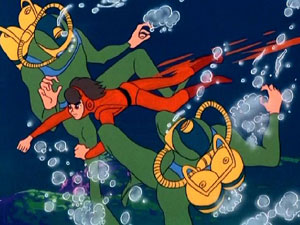
Marine Boy is set in the relatively near future, in a time when mankind has expanded its commercial and social operations under the sea. Naturally, these operations require some policing, hence the formation of the Ocean Patrol. The Patrol has to regularly protect humans and the ocean ecology from would-be conquerors, sea monsters, and malicious robots. They also investigate mysteries and search for the missing. One of their agents is Marine Boy, a lad of perhaps thirteen or so who can survive the ocean depths thanks to a handy invention called oxy-gum, which he chews prior to heading out of the P-1, the small submarine craft in which he travels. Far-fetched? Yes. But this is a children’s TV show, so we shall just have to go along with it.
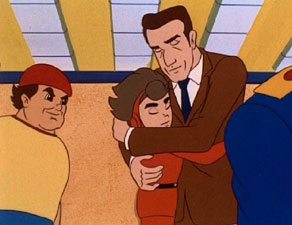
As with many programs of the era, there is no “origin” episode, and each show stands alone. We are simply asked to accept the scenario, which not only has a child swimming in the ocean without worrying about air or crushing pressure, but also his friend Neptina – who is a young mermaid. There is also a friendly dolphin named Splasher, who seems to understand Marine Boy and Neptina. The adults of this era look pretty incompetent at times, as they continually have to rely on the children to protect them from all manner of threats. The threats are impressive, too, what with all the would-be world conquerors running around down there with fleets of robots and nasty death machines. That’s not to say that the adults don’t get involved, as the Ocean Patrol has many agents and scientists working alongside Marine Boy, including his own father, Dr. Mariner; but it’s never explained just why the oxy-gum is only given to the child, and not any adult agents. Of course, the real reason is nestled in the show’s premise, which allows the young audience at home to cheer on someone near their own age.
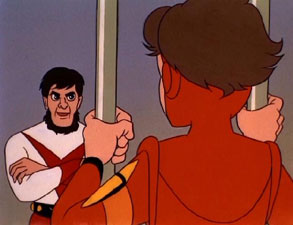
The stories are about as simplistic as one might expect, though my six-year old didn’t mind. He loves the show, which apparently holds up well in our modern era for any child who enjoys adventure stories and loopy science. He also never commented on the crude animation, obviously done on a shoestring budget. I never felt that early anime developed the knack for making the most out of limited resources the same way that U.S. production houses like Hanna-Barbera did. Marine Boy, like Astro Boy before him, tried to do too much with too little, so the action is choppy, characters talk with their backs turned in order to minimize mouth animation, and backgrounds are generally unimpressive. Of course, the advantage that Marine Boy had over Astro Boy and Gigantor is that it was filmed in color, though that didn’t distinguish it from its contemporaries Kimba or Speed Racer. The colors are often on the drab side anyway, failing to excite the optic nerves all that much. Or maybe I just didn’t care for that orange-red color of Marine Boy’s wetsuit clashing with everything else on screen.

Marine Boy is a historical curiosity, one that doesn’t hold up particularly well. The idea, I imagine, was to answer Astro Boy with a character that lived under the sea rather than flew in the sky. This was, after all, what led Filmation to develop Aquaman as a TV show following the success of The New Adventures of Superman at about the same time. The problem is that Marine Boy didn’t have the genius of Osamu Tezuka behind it, and the underwater setting, simple stories, and perhaps a lack of imagination lead to scripts becoming dull and repetitive. I’m quite glad to have had the chance to enjoy the first chunk of episodes in the form of this three-disc set; but I don’t know if I’ll be clamoring to see the rest released, unless the later episodes have something new to offer.
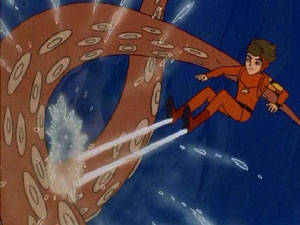
Is This Thing Loaded?
There are no extras on this set. The menus do at least offer titles for the episodes.
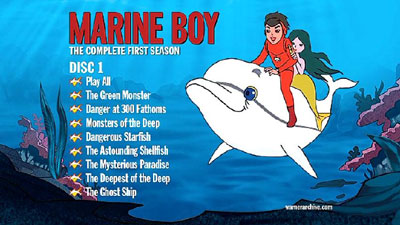
Case Study:
Marine Boy: The Complete First Season (and I‘m not sure that the term “season” actually applies here ) comes in a clear keep case with a tray. Inside the case are three DVD-R discs.
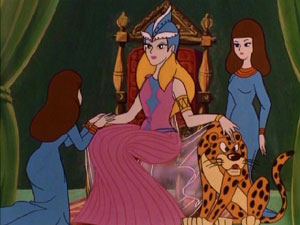
Ink And Paint:
I think I got what I expected for an on-demand pressing of an obscure 1960s cartoon. The elements are in decent but certainly not great shape, showing evidence of damage or repair, and certainly dust. The picture is soft and mildly grainy. Basically, though, I was satisfied.. As I’ve said before, when it comes to these old cartoon releases, I’m hesitant to criticize too harshly, so long as it looks no worse than it did on a 1960s television.
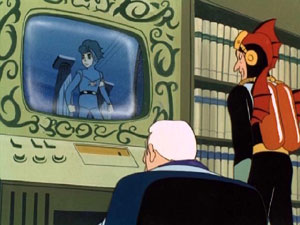
Scratch Tracks:
The audio also meets expectations, which is to say it doesn’t impress. It’s thin, comes in a narrow range, and yet manages to tell the story just fine. Only English mono is available, with no subtitles, and certainly no Japanese audio track.
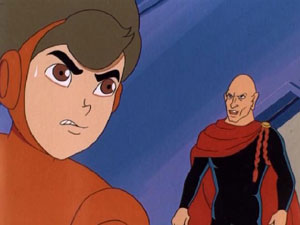
Final Cut:
I have DVDs in my collection that contain material that I enjoy and can watch over and over again, and I have classics that I can appreciate only occasionally, but I’m glad to have them handy. And then there are discs that mainly serve as curiosities, helping to fill a gap in terms of history, whether or not the material is actually historically significant. Marine Boy rode the coattails of better anime productions, and is largely forgotten now with good reason. Nevertheless, I’m sure there are folks who still remember watching this in the 1960s, and will be excited to see it again. I can relate. For those who would like Marine Boy to either relive childhood or to simply find a spot next to Speed Racer on one’s “early Americanized anime” shelf, this release should suffice. Others may feel free to search out more stimulating material.
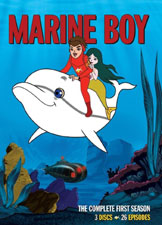 | ||
 |


